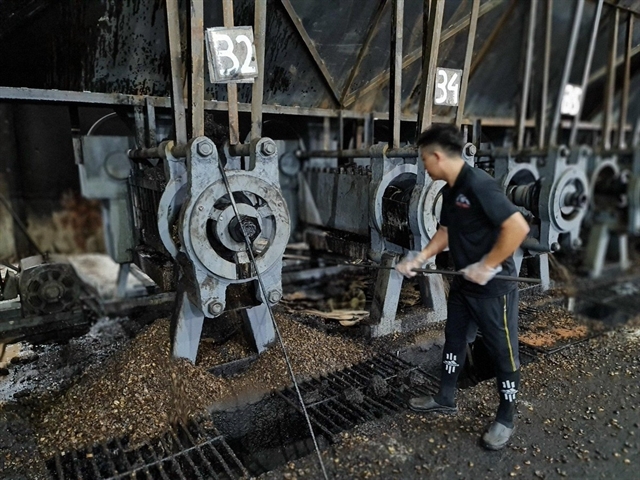 Economy
Economy

 |
| A worker uses a machine to extract bio oil from CNS. Photo nhipsongkinhdoanh.vn |
HÀ NỘI — Cashew nut shells (CNS), which were once discarded as waste and ended up in landfills, turn out to be a rich source of a highly-profitable bio oil.
Cường, co-founder of a firm producing CNS liquid in Bình Phước Province, revealed that the compression of CNS yielded CNS liquid, which could be distilled to obtain cardanol.
Cardanol finds use in various industries, including coatings, wear-resistant materials, glue and varnish. Meanwhile, the residue derived from the compression can be used as a cheap alternative for coal.
"We export CNS liquid to big markets, such as China, Korea, Japan and Europe," he said.
He also said cashew by-product industries were lucrative but increasingly competitive since more and more firms were moving into the industries.
Tạ Quang Huyên, Director General of the Hoàng Sơn 1 Company, remarked that CNS prices this year were three times higher than those in previous years.
The rise in prices had doubled the contribution of CNS revenues to the company's total revenues, from 10 per cent to 20 per cent, and offset its loss caused by falling cashew nut prices.
"All parts of cashew trees, from their trunk to their nut shells, could make profits," he said.
He estimated aggregated CNS-derived products, including CNS liquid and residue, at about US$400 million, accounting for around 15 per cent of the cashew industry.
Việt Nam is well-positioned in the international CNS liquid market because the country has almost no competitors, according to Huyên. India, another large producer, produces the liquid for domestic use only.
A firm producing CNS liquid in Đồng Nai Province claimed that it produced 2,000 tonnes of residue for domestic use and exported 6,000 tonnes of CNS liquid annually.
The conditions are more favourable this year as CNS liquid prices are on the rise and international demand is ample. Unfortunately, the company has ruled out the possibility of expansion because its financial position is insufficient to invest in new production lines.
Another firm has estimated that each tonne of cashew yields about 300 kilos of nuts and 700 kilos of shells, from which roughly 154 kilos of CNS liquid can be extracted.
It said cardanol, a constituent of the liquid, could be used in coatings on marine structures, in heat-, corrosion- and pressure-resistant materials, and in components in electronics.
Despite cardanol's profitability, most domestic firms focus only on CNS liquid and have no interest in distilling it into cardanol. They lose out financially to Chinese firms, who import CNS to produce CNS liquid and separate the agent from it.
Another firm underscored the high costs of distillation equipment as the main reason for the lack of investment in the cardanol industry.
It also said few domestic firms engaged in CNS-derived pellets, an easy-to-transport commodity that can add to wood pellet exports, on account of costs.
Vũ Trọng Khải, an independent expert on agricultural policy, asserted that all agro-forestry-fishery by-products, including CNS, could make huge profits under the circular economy model.
Unfortunately, few domestic firms had thought of turning the by-products to good use, resulting in them going down the drain unused. In fact, the technology required for processing the by-products was within reach and firms could easily obtain it from developed countries.
"Each hectare of agricultural land under the circular economy model could yield VNĐ1 billion annually. Meanwhile, the same hectare yields just VNĐ300 million in low-tech industries," he said.
He urged firms to change their mindset and embrace the circular economy model to improve profitability and reduce environmental impact. He also called on the authorities to develop favourable policies to promote green transition. — VNS




